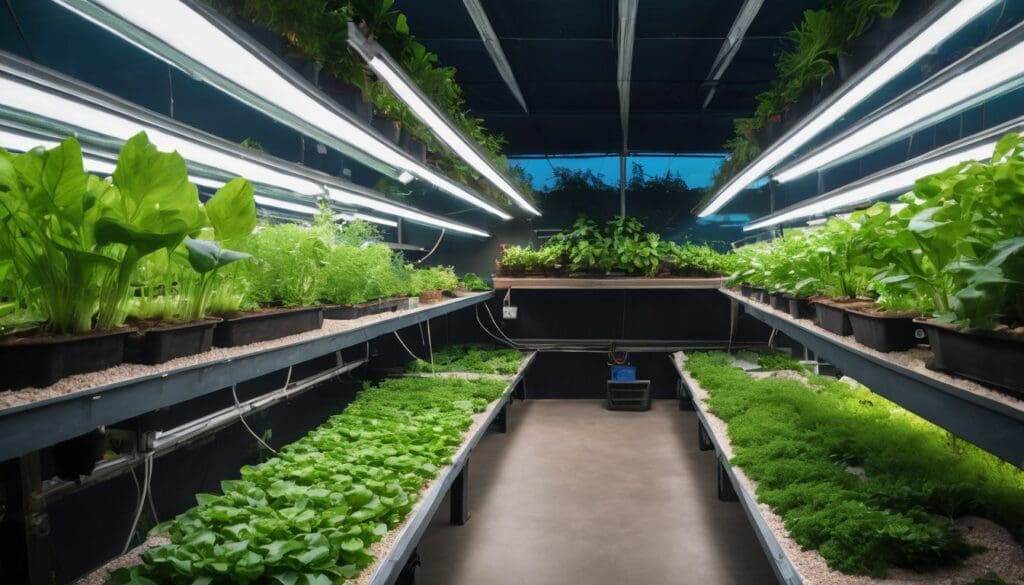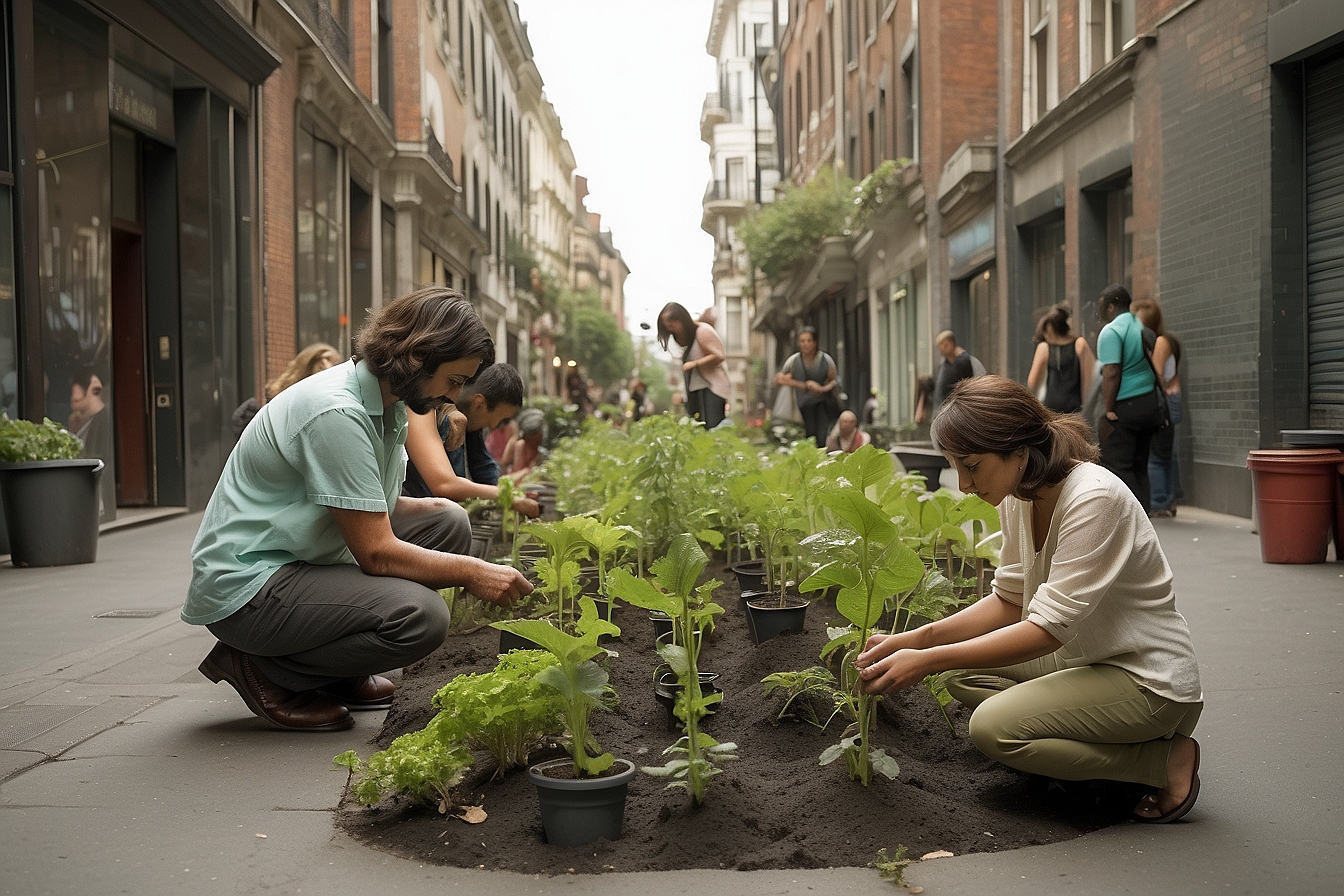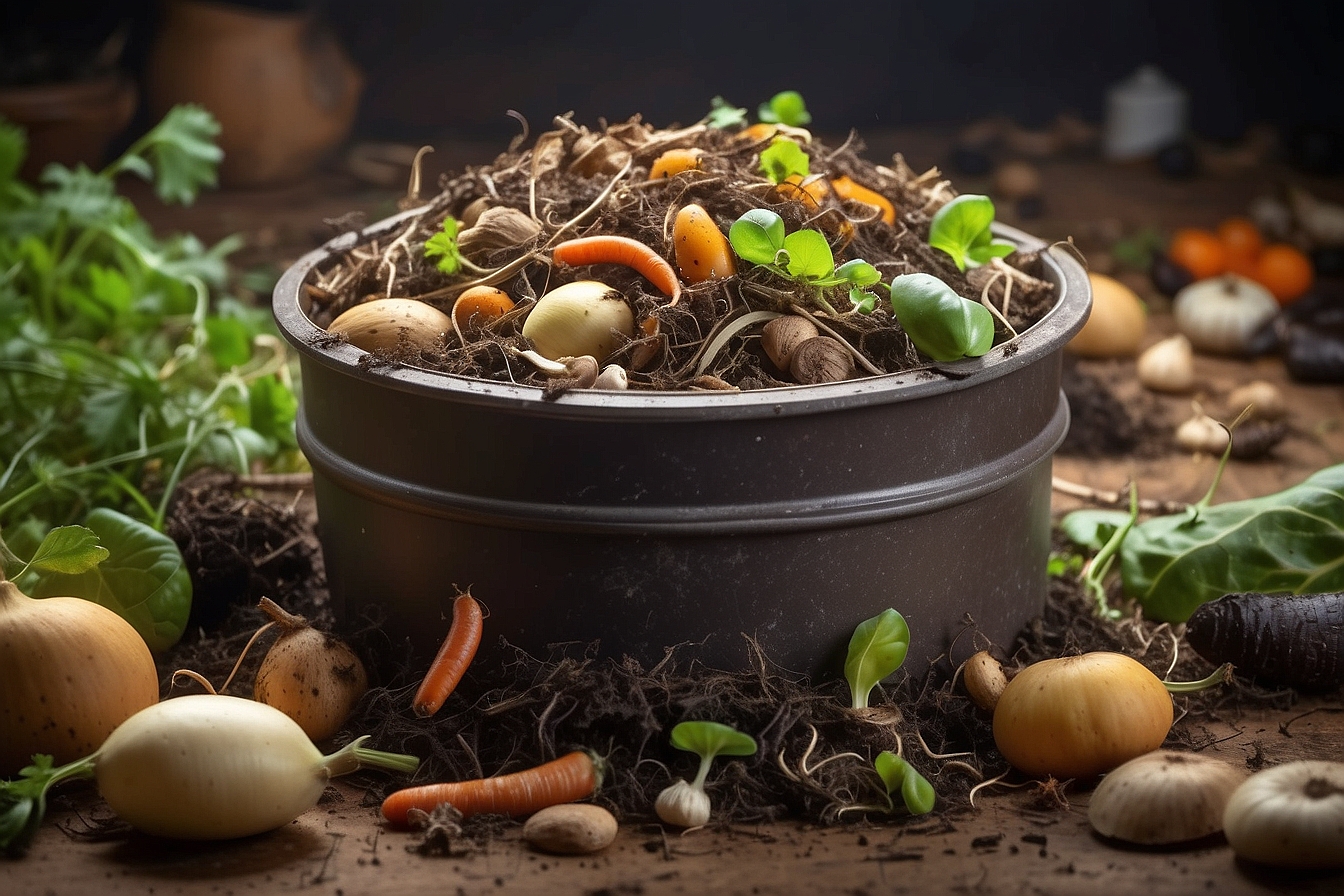Have you ever pondered whether there might be more to your garden than simply offering a feast for the eyes? We certainly have, especially when we learnt that an astonishing 95% of our freshwater is consumed by traditional agriculture.
This knowledge set us on a path to discover the marvels of aquaponics, where fish and plants coexist in delightful harmony. Why not take the plunge into this guide? Embracing aquaponics may be simpler than one imagines!
Key Takeaways
- Aquaponics combines fish farming with soilless plant cultivation, creating a closed-loop system where fish waste provides nutrients for plants and plants clean the water for fish.
- Key components of an aquaponic system include the fish tank, grow bed, water pump, and plumbing to circulate water efficiently between these elements.
- There are several types of aquaponic systems — media-based, raft, NFT (Nutrient Film Technique), and hybrid — each suited to different needs and space requirements.
- Growing plants in an aquaponic system is environmentally friendly as it conserves space and reduces water use by recycling nutrient-rich water through its closed-loop design.
- You can cultivate a variety of produce in an aquaponics system at home including leafy greens, herbs, microgreens, vegetables, and even fruiting plants.
Understanding and Explaining Aquaponics
Aquaponics is a gardening method that combines fish farming (aquaculture) and hydroponic growing in a symbiotic relationship. It works by using the waste produced by the fish to provide nutrients for the plants, which in turn clean the water for the fish.
Definition of aquaponics
We dive into the world of aquaponics, a sustainable farming technique that combines raising fish in tanks (aquaculture) with soilless plant cultivation (hydroponics). In this closed-loop system, fish waste provides an organic nutrient source for the plants.
Simultaneously, plants purify the water for the fish to live. This symbiotic relationship mimics natural ecosystems and utilises both hydroponic growing methods and aquaculture.
Our homes can become eco-friendly powerhouses using DIY aquaponics systems. We create a space-saving garden that not only grows vegetables but also supports aquatic life. The process reduces water usage compared to traditional gardening since it recirculates water within the system.
Living organically becomes easier as we harness nature’s cycles to produce food without synthetic fertilisers or pesticides.
How it works
Now, let’s delve into how an aquaponics system works. In simple terms, it is a closed-loop ecosystem where fish waste provides nutrients for the plants, and the plants filter and purify the water that is then returned to the fish tank.
The process begins with the fish excreting ammonia through their gills and urine. This toxic substance is then broken down by beneficial bacteria in the grow bed into nitrites and nitrates which act as natural fertilisers for plant growth.
As the water containing these nutrients circulates through the grow beds, it nourishes the plants before being recirculated back into the fish tank, thus creating a mutually beneficial environment for both aquatic life and plant cultivation.
Furthermore, this self-sustaining system eliminates soil from its equation altogether; instead, employing soilless media such as clay pebbles or gravel to anchor and support plant roots while allowing them access to nutrient-rich water.
Components of an Aquaponic System
The components of an aquaponic system include a fish tank, where the fish are kept and their waste is collected; a grow bed, where plants are grown using the nutrient-rich water from the fish tank; a water pump, which circulates the water between the two components; and plumbing to connect everything together.
These components work together in a closed-loop system to create a sustainable environment for both fish and plants.
Fish tank
The fish tank is a crucial component of an aquaponic system, as it houses the aquatic species that provide the necessary nutrients for plant growth. Selecting the right fish is essential; popular choices include tilapia and trout due to their fast growth rate and resilience in varied conditions.
The tank should be large enough to accommodate the chosen fish species while allowing room for proper circulation and filtration of water. Additionally, ensuring that the tank is made from non-toxic materials and has adequate oxygen levels is vital for maintaining a healthy environment for both the fish and plants.
Caring for the fish involves monitoring their health, feeding them appropriately with high-quality organic feed, and managing water quality through regular testing and maintenance.
Grow bed
The grow bed is where the magic of aquaponics happens. It’s a container filled with a growing medium such as gravel or clay pebbles, where plants are cultivated. The grow bed serves two essential purposes in an aquaponic system: it acts as a biofilter, removing harmful substances from the water and providing nutrients to the plants at the same time.
As water flows through the grow bed, beneficial bacteria break down fish waste into nitrites and nitrates which serve as fertiliser for the plants.
Plants thrive in this environment, absorbing nutrients while purifying the water for the fish. This symbiotic relationship makes aquaponics an incredibly efficient way to produce both fish and vegetables in a closed-loop system.
Water pump
The water pump in an aquaponics system plays a crucial role in circulating the water from the fish tank to the grow beds. It ensures that the nutrient-rich water reaches the plants, providing them with essential nutrients and oxygen.
By continuously moving the water, the pump helps in preventing stagnation and promotes healthier root growth for the plants.
A reliable water pump is necessary for maintaining a well-functioning aquaponics system. It should be chosen based on factors such as flow rate, head height, and energy efficiency to ensure optimal performance while minimising energy consumption.
Plumbing
Connecting the water pump to the plumbing system is a crucial step in ensuring the smooth operation of your aquaponics setup. The plumbing connects the fish tank, grow bed, and water pump, allowing for proper circulation and distribution of nutrient-rich water throughout the system.
It’s essential to use high-quality pipes and fittings that are durable and resistant to corrosion, as they will be constantly exposed to water. Additionally, regular inspection and maintenance of the plumbing system are necessary to prevent leaks or blockages that could disrupt the flow of water within your aquaponics system.
Properly designed and installed plumbing ensures efficient water flow between components, which is vital for maintaining a healthy environment for both your plants and fish. It’s important not to overlook this aspect when setting up an aquaponics system at home since well-maintained plumbing contributes significantly to its long-term success.
Types of Aquaponics Systems
There are four main types of aquaponics systems including media-based, raft, NFT, and hybrid systems. Each system has its own unique set up and benefits so it’s important to research and choose the right one for your home aquaponics setup.
To learn more about these different systems, read on in our blog!
Media based system
In a media-based aquaponics system, plants grow in a medium such as gravel or clay pellets. The grow bed is flooded with nutrient-rich water from the fish tank, providing essential nutrients for plant growth.
The media also serves as a habitat for beneficial bacteria that convert fish waste into forms usable by the plants. This type of system offers excellent support to plants and provides ample surface area for bacterial colonization, ensuring efficient nutrient cycling within the closed-loop ecosystem.
With media-based systems, the choice of medium can impact plant growth and water flow, making it crucial to select one that suits your specific needs and preferences. Gravel is commonly used due to its affordability and versatility.
Raft system
The media-based system provides a solid foundation for understanding aquaponics, and the next step is to explore the raft system. In this type of aquaponic setup, plants are placed on floating rafts that sit directly on the water surface in the grow bed.
The roots dangle down into the water where they can access nutrients from fish waste. This method allows for efficient use of space and is particularly well-suited for growing leafy greens like lettuce, spinach, and herbs such as basil and mint.
The simplicity of this system makes it an ideal choice for beginners entering the world of aquaponics at home.
Nutrient Film Technique (NFT) system
Moving on from the Raft system, another type of aquaponics system that is popular among home growers is the Nutrient Film Technique (NFT) system. In this setup, plants are placed in small plastic cups or baskets, and their roots dangle into a thin film of nutrient-rich water flowing through narrow channels.
This continuous flow of water provides oxygen to the roots while delivering essential nutrients for optimum plant growth. The NFT system is ideal for cultivating leafy greens and herbs due to its efficient use of space and ability to produce high yields within a limited area.
Employing an NFT system allows environmentally conscious individuals to grow fresh produce at home while minimising water usage and promoting sustainability. With its closed-loop design, it exemplifies the harmonious relationship between fish waste conversion to plant nutrition, making it an excellent choice for those seeking to practise conservation in their everyday lives.
Hybrid system
Hybrid aquaponic systems combine the best of both media-based and raft systems. By integrating elements of these two methods, hybrid systems can effectively grow a wider variety of plants while maximising space usage.
The fish waste is filtered in a media bed, then the nutrient-rich water flows into the raft system where plants are grown directly on floating platforms. This seamless combination allows for increased productivity and diversity within a single setup.
For those looking to optimise their aquaponics setup while expanding their crop options, understanding how hybrid systems work can be an exciting next step in sustainable home growing.
It’s important to consider the specific needs of different plant types when deciding which system to implement.
Benefits of Aquaponics
– Aquaponics systems are efficient in their use of space, allowing for the growth of more plants in a smaller area.
– With aquaponics, water usage is reduced as it circulates between the fish and plants, creating a closed-loop system.
Efficient use of space
Aquaponics maximises space usage by vertically stacking plants, optimising the available area. This allows for a higher yield in a smaller footprint compared to traditional soil gardening.
The combination of fish and plant cultivation in one system creates a closed-loop environment, where the natural waste products from the fish provide essential nutrients for plant growth, further enhancing space efficiency.
By integrating aquaponics into limited spaces such as urban apartments or small yards, individuals can cultivate their own fresh produce without requiring extensive land or water resources.
Reduced water usage
By using a closed-loop system, we significantly reduce water usage in aquaponics. This is achieved by recycling the same water between the fish and plant components of the system. The plants absorb nutrients from the water, purifying it for recirculation back to the fish tank.
This efficient use of water not only conserves this precious resource but also minimises wastewater discharge, making aquaponics an environmentally friendly choice.
To further enhance water conservation in aquaponics, implementing strategies such as monitoring pH levels and minimising evaporation can help maintain optimal conditions for both the fish and plants while reducing overall water consumption.
Organic and sustainable
To continue our discussion on aquaponics, let’s explore the organic and sustainable benefits of this innovative system. Aquaponics offers a natural approach to growing food, using nutrient-rich fish waste to provide all the essential nutrients for plant growth.
By cultivating plants in a closed-loop environment where water is recirculated between the fish tank and grow beds, aquaponics minimises environmental impact by conserving water and reducing the need for synthetic fertilisers.
This method fosters an organic ecosystem that promotes healthy plant growth without relying on harmful chemicals or pesticides. Embracing aquaponics at home aligns with environmentally conscious values while supporting sustainable agriculture practices.
Setting Up and Maintaining an Aquaponics System
Choose a suitable location and space for your aquaponics system, cycle the system to establish beneficial bacteria, and maintain water quality and fish health. Troubleshoot common issues regularly to keep your system running smoothly.
Ready to start your own aquaponics garden at home? Read on for more tips and information!
Choosing the right location and space
When choosing the right location for an aquaponics system at home, consider a space that receives plenty of natural sunlight. Position the setup near a south-facing window or under grow lights to provide adequate light for plant growth.
Additionally, ensure the area has easy access to water and electrical outlets for the water pump. Remember to select an area with stable temperatures to support both fish and plant health.
It’s important not to place your aquaponics system in direct sunlight or near heating sources that can cause fluctuations in water temperature. If you plan on setting up a larger system, make sure there is enough room around it for maintenance and accessibility to all components.
Cycling the system and establishing bacteria
To cycle the aquaponics system and establish bacteria, begin by adding ammonia to kick-start the nitrogen cycle. This can be done using fish food, small amounts of liquid ammonia, or even a piece of raw fish.
Allow the ammonia level to rise to around 4 ppm before introducing any fish into the system. As the beneficial bacteria grow and convert ammonia into nitrites and then nitrates, monitor water parameters regularly using a test kit.
Regularly testing for pH, ammonia, nitrites, and nitrates ensures that the bacterial colonies are successfully established in the system. Once levels are stable and suitable for supporting aquatic life, slowly introduce your chosen fish species to their new environment.
Maintaining water quality and fish health
To maintain water quality and ensure fish health in your aquaponics system, regularly test the water parameters such as pH, ammonia, nitrite, and nitrate levels. This will help you to monitor the overall health of the system and make necessary adjustments to keep it balanced.
Additionally, clean the filters and remove any uneaten fish food or debris from the fish tank and grow bed. Proper filtration is essential for maintaining a healthy environment for both the fish and plants.
Regularly checking on the behaviour and appearance of your fish can also provide valuable insights into their health. Look out for signs of stress or disease such as lethargy, loss of appetite, or abnormal swimming patterns.
By observing these indicators early on, you can take proactive measures to address any potential issues before they escalate.
Troubleshooting common issues
When troubleshooting common issues in your aquaponics system, start by checking the water quality and clarity. Look for signs of ammonia or nitrite spikes, which may indicate a problem with the nitrogen cycle.
Test the pH level to ensure it falls within the optimal range for both fish and plants. Additionally, inspect the pumps, pipes, and grow beds for any blockages or leaks that could disrupt the flow of water and nutrients.
Regular maintenance and observation are crucial to identifying and addressing potential problems early on.
If you notice poor plant growth or unhealthy fish, consider adjusting the feeding regimen or monitoring temperature fluctuations in the system. Remember to keep an eye out for pests that may affect your plants as well.
What to Grow in Aquaponics
When it comes to what you can grow in your aquaponics system, the options are plentiful. From leafy greens and herbs to microgreens, vegetables, and even fruiting plants, there’s really no limit to what you can produce right at home.
With the right setup and care, you’ll be amazed at the variety and quality of produce that you can grow in your own backyard or indoor space.
Leafy greens
Leafy greens thrive in aquaponic systems due to their ability to grow quickly and efficiently. They include spinach, lettuce, kale, and Swiss chard. These greens are packed with essential nutrients like vitamins A, C, and K, as well as minerals such as iron and calcium.
Their shallow roots make them ideal for the grow beds of an aquaponics system. Spinach, for instance, grows rapidly in the nutrient-rich water from the fish tank while benefiting from the continuous flow of oxygen.
A mix of leafy greens adds variety and nutritional value to your diet while also keeping your aquaponic system balanced. By absorbing nitrates produced by fish waste—instead of those nitrates building up in a conventional fish tank—leafy greens contribute to a symbiotic relationship that benefits both plants and fish.
Herbs
Moving on from leafy greens, herbs are another excellent option for your aquaponics system. They thrive in the nutrient-rich environment created by the fish waste and provide a flavourful addition to your cooking.
Herbs such as basil, mint, cilantro, and parsley are popular choices due to their versatility and high market demand. With proper care and attention to water quality, they can flourish in an aquaponic setting.
Growing herbs in your aquaponics system not only adds variety to your produce but also brings fragrance and freshness into your home. Whether you’re whipping up a culinary masterpiece or simply garnishing a dish, having fresh herbs at your fingertips is both convenient and rewarding.
Microgreens
Moving on from growing herbs, microgreens are another excellent option for your aquaponics system. These tiny and flavourful greens are harvested at an early stage of growth, just after the first true leaves have developed.
They are packed with nutrients and can add a burst of flavour to your dishes. Microgreens grow quickly and are ready for harvest in just 1-3 weeks, making them a fast and rewarding addition to your aquaponics setup.
You can easily incorporate a variety of microgreens such as radish, arugula, kale, and broccoli into your meals, elevating both the taste and nutrition content.
Vegetables
Vegetables thrive in aquaponic systems, especially leafy greens like lettuce and kale. They benefit from the nutrient-rich water provided by the fish waste, resulting in robust growth and vibrant leaves.
Additionally, herbs such as basil, mint, and coriander flourish in this environment due to the consistent access to essential nutrients. Moreover, microgreens can be easily cultivated within an aquaponic setup as they require minimal space and provide a quick harvest for culinary use.
Furthermore, some fruiting plants such as tomatoes and peppers can also be successfully grown in aquaponics with appropriate support for their vines or stems. Incorporating these varieties of produce into an aquaponic system offers a sustainable way to cultivate fresh, organic vegetables at home.
Fruiting plants
When considering what to grow in an aquaponics system, fruiting plants are a popular choice due to their high nutritional value and delicious taste. Tomatoes, bell peppers, strawberries and cucumbers are examples of fruiting plants that thrive in aquaponics setups.
These plants require adequate support for their fruits as they mature and ripen. With the right care and attention to water quality and nutrient levels, these vibrant fruits can flourish in your aquaponic garden.
As fruiting plants develop, it’s important to monitor their growth closely. Regular pruning and maintenance are essential for ensuring healthy yields. By understanding the specific needs of each type of fruiting plant you choose to grow, you can optimise your aquaponic system for bountiful harvests year-round.
Conclusion
In conclusion, aquaponics is a sustainable and space-saving way to grow plants at home. You can set up an aquaponics system by understanding its components and choosing the right location.
Maintaining water quality, fish health, and troubleshooting are essential for a successful system. With the right knowledge and effort, you can grow a variety of produce in your own aquaponics setup.
FAQs
1. What are the basics of aquaponics at home?
Aquaponics combines fishkeeping and hydroponics in a closed-loop system, recycling water and nutrients to grow plants efficiently.
2. How does an aquaponics system work?
In an aquaponics setup, fish waste provides nutrients for plants, which in turn clean the water for the fish – it’s a sustainable cycle!
3. Is an aquaponic setup difficult to design for beginners?
Not at all! Beginners can follow a simple aquaponics setup diagram that outlines the essential components needed to create their own system.
4. Can I save space with an aquaponics system at home?
Yes, you can craft a spacesaving design that maximises your gardening area by vertically stacking plants above your fish tank.
5. What’s the difference between aquaponics and hydroponics?
Aquaponics involves both fish and plants working together while hydroponics only focuses on plant growth using nutrient-rich water solutions without fish.





